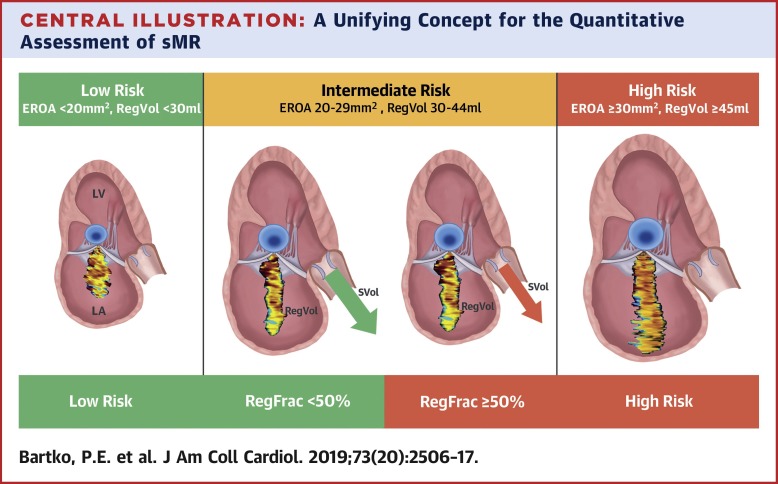当前位置:
X-MOL 学术
›
J. Am. Coll. Cardiol.
›
论文详情
Our official English website, www.x-mol.net, welcomes your
feedback! (Note: you will need to create a separate account there.)
A Unifying Concept for the Quantitative Assessment of Secondary Mitral Regurgitation
Journal of the American College of Cardiology ( IF 21.7 ) Pub Date : 2019-05-01 , DOI: 10.1016/j.jacc.2019.02.075 Philipp E. Bartko , Henrike Arfsten , Gregor Heitzinger , Noemi Pavo , Aurel Toma , Guido Strunk , Christian Hengstenberg , Martin Hülsmann , Georg Goliasch
Journal of the American College of Cardiology ( IF 21.7 ) Pub Date : 2019-05-01 , DOI: 10.1016/j.jacc.2019.02.075 Philipp E. Bartko , Henrike Arfsten , Gregor Heitzinger , Noemi Pavo , Aurel Toma , Guido Strunk , Christian Hengstenberg , Martin Hülsmann , Georg Goliasch

|
BACKGROUND
Diverging guideline definitions for the quantitative assessment of severe secondary mitral regurgitation (sMR) reflect the lacking link of the sMR spectrum to mortality and has introduced a source of uncertainty and continuing debate. OBJECTIVES
The current study aimed to define improved risk-thresholds specifically tailored to the complex nature of sMR that provide a unifying solution to the ongoing guideline-controversy. METHODS
This study enrolled 423 heart failure patients under guideline-directed medical therapy and assessed sMR by effective regurgitant orifice area (EROA), regurgitant volume (RegVol), and regurgitant fraction (RegFrac). RESULTS
Measures of sMR severity were consistently associated with 5-year mortality with a hazard ratio of 1.42 for a 1-SD increase (95% confidence interval [CI]: 1.25 to 1.63; p < 0.001) for EROA, 1.37 (95% CI: 1.20 to 1.56; p < 0.001) for RegVol, and 1.50 (95% CI: 1.30 to 1.73; p < 0.001) for RegFrac. Results remained statistically significant after bootstrap- or clinical confounder-based adjustment. Spline-curve analyses showed a linearly increasing risk enabling the ability to stratify into low-risk (EROA <20 mm2 and RegVol <30 ml), intermediate-risk (EROA 20 to 29 mm2 and RegVol 30 to 44 ml), and high-risk (EROA ≥30 mm2 and RegVol ≥45 ml) groups. In the intermediate-risk group, a RegFrac ≥50% as indicator for hemodynamic severe sMR was associated with poor outcome (p = 0.017). A unifying concept based on combined assessment of the EROA, the RegVol, and the RegFrac showed a significantly better discrimination compared with the currently established algorithms. CONCLUSIONS
Risk-based thresholds tailored to the pathophysiological concept of sMR provide a unifying solution to the ongoing guideline controversy. An algorithm based on the combined assessment of the unifying cutoffs for EROA, RegVol, and RegFrac improves risk prediction compared with currently established grading.
中文翻译:

定量评估继发性二尖瓣反流的统一概念
背景 严重继发性二尖瓣关闭不全 (sMR) 定量评估的不同指南定义反映了 sMR 谱与死亡率之间缺乏联系,并引入了不确定性和持续争论的来源。目标 当前的研究旨在定义专门针对 sMR 的复杂性质定制的改进风险阈值,为正在进行的指南争议提供统一的解决方案。方法 本研究招募了 423 名接受指南指导的药物治疗的心力衰竭患者,并通过有效反流口面积 (EROA)、反流体积 (RegVol) 和反流分数 (RegFrac) 评估 sMR。结果 sMR 严重程度的测量始终与 5 年死亡率相关,1-SD 增加的风险比为 1.42(95% 置信区间 [CI]:1.25 至 1.63;p < 0。001)对于 EROA,1.37(95% CI:1.20 到 1.56;p < 0.001)对于 RegVol,1.50(95% CI:1.30 到 1.73;p < 0.001)对于 RegFrac。在基于引导或临床混杂因素的调整后,结果仍然具有统计学意义。样条曲线分析显示风险呈线性增加,从而能够将风险分层为低风险(EROA <20 mm2 和 RegVol <30 ml)、中风险(EROA 20 至 29 mm2 和 RegVol 30 至 44 ml)和高风险风险(EROA ≥30 mm2 和 RegVol ≥45 ml)组。在中危组中,作为血流动力学严重 sMR 指标的 RegFrac ≥ 50% 与较差的结果相关(p = 0.017)。与当前建立的算法相比,基于对 EROA、RegVol 和 RegFrac 的综合评估的统一概念显示出明显更好的区分。结论 根据 sMR 病理生理学概念量身定制的基于风险的阈值为正在进行的指南争议提供了统一的解决方案。与当前建立的分级相比,一种基于对 EROA、RegVol 和 RegFrac 的统一临界值的组合评估的算法改进了风险预测。
更新日期:2019-05-01
中文翻译:

定量评估继发性二尖瓣反流的统一概念
背景 严重继发性二尖瓣关闭不全 (sMR) 定量评估的不同指南定义反映了 sMR 谱与死亡率之间缺乏联系,并引入了不确定性和持续争论的来源。目标 当前的研究旨在定义专门针对 sMR 的复杂性质定制的改进风险阈值,为正在进行的指南争议提供统一的解决方案。方法 本研究招募了 423 名接受指南指导的药物治疗的心力衰竭患者,并通过有效反流口面积 (EROA)、反流体积 (RegVol) 和反流分数 (RegFrac) 评估 sMR。结果 sMR 严重程度的测量始终与 5 年死亡率相关,1-SD 增加的风险比为 1.42(95% 置信区间 [CI]:1.25 至 1.63;p < 0。001)对于 EROA,1.37(95% CI:1.20 到 1.56;p < 0.001)对于 RegVol,1.50(95% CI:1.30 到 1.73;p < 0.001)对于 RegFrac。在基于引导或临床混杂因素的调整后,结果仍然具有统计学意义。样条曲线分析显示风险呈线性增加,从而能够将风险分层为低风险(EROA <20 mm2 和 RegVol <30 ml)、中风险(EROA 20 至 29 mm2 和 RegVol 30 至 44 ml)和高风险风险(EROA ≥30 mm2 和 RegVol ≥45 ml)组。在中危组中,作为血流动力学严重 sMR 指标的 RegFrac ≥ 50% 与较差的结果相关(p = 0.017)。与当前建立的算法相比,基于对 EROA、RegVol 和 RegFrac 的综合评估的统一概念显示出明显更好的区分。结论 根据 sMR 病理生理学概念量身定制的基于风险的阈值为正在进行的指南争议提供了统一的解决方案。与当前建立的分级相比,一种基于对 EROA、RegVol 和 RegFrac 的统一临界值的组合评估的算法改进了风险预测。






























 京公网安备 11010802027423号
京公网安备 11010802027423号